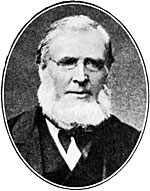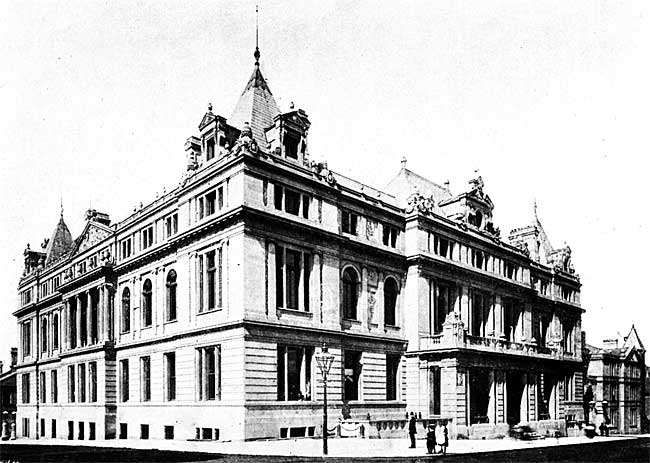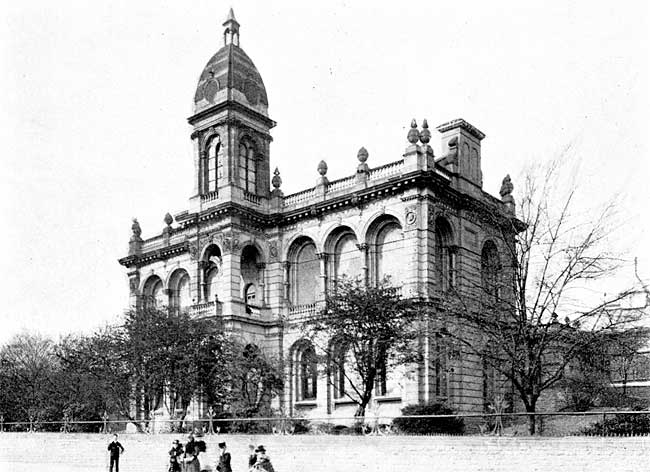
The late Mr. Sydney Smith, Inventor of the Steam Gauge. (Sydney Smith and Sons, Basford.)
Among the principal public buildings, attention may first be directed to
The New Guildhall.
This handsome structure, having its main entrance in Burton Street, is of ornate design in the Early French Renaissance style, constructed of stone, with facades to both that thoroughfare and Sherwood Street. The spacious interior is arranged for the accommodation of the two Police Courts, the offices of the Town Clerk, the Medical Officer of Health, the Borough Engineer and Fire Brigade. In Burton Street also is the Central Police Station, and in Sherwood Street is the Fire Station, with large yard in the rear for drill or exercise purposes.
The present Lord Mayor of Nottingham is Mr. Edward H. Fraser, who occupies for the second time the position of chief magistrate of the city. His predecessors have been :— In 1895 Joseph Bright, in 1894 Joseph Bright, in 1893 Frederick Pullman, in 1892 Anderson Brownsword, in 1891 Richard Fitzhugh, in 1890 Samuel Herrick Sands, in 1889 Edward Goldschmidt, in 1888 John Renals, in 1887 John Turney, in 1886 John Turney, in 1885 William Lambert, in 1884 John Burton, in 1883 John Manning, in 1882 Leonard Lindley, in 1881 Edward Goldschmidt, in 1880 Edward Gripper, in 1879 Sir J. Oldknow, Kt., in 1878 Sir J. Oldknow, Kt., in 1877 W. George Ward and Sir James Oldknow, in 1876 John Warren Bowers, in 1875 John Manning, in 1874 William Lambert, in 1873 John Howitt, in 1872 William Foster, in 1871 William George Ward, in 1870 John Manning, in 1869 James Oldknow, and in 1868 John Barber (second time).

The Guildhall.
The Municipal School of Art.
Situate by the entrance to the beautiful Arboretum Gardens (of which a view appears on page 13) is the School of Art—a fine brick and stone building in the Venetian School of Italian architecture—one of the most widely appreciated institutions from an educational point of view, even in a town which has ever been foremost in its encouragement of artistic teaching, as having an important bearing on the chief industries of the district. The management of the School of Art is carried out by a committee of the Corporation, the course of study comprising all the various branches of training from freehand to the advanced sections of painting in oil, lise and antique, decorative compositions, etc.; and in connection with the parent institution, classes have been established in the suburbs, which are also well attended. These are held at the Board Schools in Queen's Walk; Stanley Road Higher Grade Board School; Southwark, Old Basford, and St. Ann's Well Road. The Head Master is Mr. Joseph Harrison, and the Secretary Mr. H. A. Goodyer.

The School of Art.
Independently of the School of Art, the University, and the High School, of which we are able to present illustrations (see pages 12 and 13), the city possesses a High School for Girls in Arboretum Street; a Congregational Institute in forest Road, for training young men in pastoral and home mission work; a Midland Baptist College (dating from 1797) in Forest Road, W.; the Blue Coat School in Mansfield Road, founded in 1706; and a Hebrew School in Chaucer Street.
